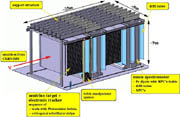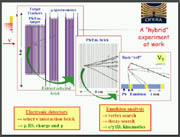| |
The OPERA detector
The signal of the occurrence of nu_mu <-> nu_tau oscillations is the CC interaction of tau neutrinos in the detector target: nu_tau + N --> tau- + X. The reaction is identified by the detection of the tau lepton in the final state through the decay topology and its decay modes into an electron, a muon and a single charge hadron.
The braching ratios of the three single-prong decay modes are 17.8%, 17.7% and 49.5% for the electronic, muonic and hadronic channel, respectively. For the muonic decay mode the presence of the penetrating muon track allows an easier vertex finding. The potential background from large angle scattering of muons produced in nu_mu CC interactions can be reduced to a tolerable level by applying cuts on the kink angle and on the transverse muon momentum at the decay vertex. Hadronic decay modes have the largest branching ratio but are affected by background due to hadron reinteractions. One of the primary hadrons, in fact, can interact in the first lead plates and, if the other products of this interaction are not detected in the emulsion, it may simulate the charged single-prong decay of the tau. Strong kinematical cuts can be used to reduce this background. An important tool for background rejection is the determination of the transverse momentum of the daughter particle with the respect to the direction of the tau track candidate. For electronic tau decays the ECC technique is well suited to identify electrons and to determine their energy by measuring the density of track segments associated to their showering in the brick. For charged hadrons and muons, the momentum is deduced from the measurement of the multiple scattering in the lead plates. As discussed above, the muon momentum is also measured by the electronic detectors in a large fraction of the cases.
Fig. 3 shows the OPERA detector with its components. The OPERA detector with a total mass of 1.766 ktons consists of two equal super modules, each divided into a target and the muon detector downstream. The target consists of the so-called Emulsion Cloud Chambers (ECC) shown in fig. 4 .
A target cell is composed of a 1mm thick lead plate as target followed by a thin film made up of a pair of emulsion layers 50μm thick on either side of a 200μm plastic base. A charged particle produces two track segments in each film. The number of grain hits in 50μm (15 - 20) is adequate for reconstruction of track segments by means of automatic scanning devices and ensures redundancy in the measurement of particle trajectories. To handle the emulsion 56 target cells are arranged in so-called bricks. About 235000 bricks arranged in several walls compose the OPERA detector. The target electronic detectors placed downstream of each emulsion brick wall are used to select the brick (to be removed for analysis) where the neutrino interaction took place and to guide the scanning, by defining the region of the films to be scanned. The baseline design foresees the use of extruded plastic scintillator strips read out by wavelength-shifting fibers coupled to photo-detectors at both ends. The target electronic detectors are also used to sample the energy of hadronic showers and to contribute to the identification and reconstruction of penetrating tracks as fig. 5 shows.
A muon spectrometer constitutes the downstream part of each detector super-module. Its purpose is to identify muons and to measure the sign of their charge for background rejection. For given muon identification criteria the background of the nu_tau signal from the single or associated charm production in nu_mu CC interactions is proportional to the inefficiency of identifying the primary muon. The goal is to keep this inefficiency below ~5%, while retaining high purity for the reconstructed muon sample. For muonic tau decay candidates the residual background from charmed particles produced in nu_mu CC interactions and decaying into muons is further reduced by the measurement of the charge of the secondary muon. The charge measurement is practically impossible for the other tau decay modes. The measurement of the muon momentum in the spectrometer complements the momentum measurements performed with the emulsion films by the evaluation of the multiple scattering in the lead/emulsion sandwich structure of the brick. Each muon spectrometer consists of a dipolar magnet (1.55T) made of two iron walls interleaved by pairs of high resolution trackers. The high resolution trackers (Precision Trackers) consists of vertical drift tube planes with an intrinsic resolution of less than 300μm in the bending direction. The two tracker planes housed between the two magnet walls provide an angular measurement of the track with a 1m lever arm. The lever arm for the external trackers is ~0.5m. This design leads to a momentum resolution smaller than 30% in the relevant kinematic domain. Resistive Plate Chambers (RPC) with inclined strips, called XPC, are combined with the High Precision Trackers to provide unambiguous track reconstruction in space. The so-called Inner Trackers, also made of RPC in horizontal and vertical directions, are inserted between the magnet iron plates. It allows a coarse tracking inside the magnet to identify muons and ease track matching between the Precision Trackers. They also provide a measurement of the tail of the hadronic energy leaking from the target and of the range of muons which stop in the iron. Through the measurement of the muon charge and momentum in nu_mu CC interactions, the muon spectrometer provide information on the beam, such as the total flux, the energy spectrum and the anti nu_mu contamination.
read more: Physics motivation
read more: The CNGS project
|
|
 |
| > |
Fig. 1: OPERA detector (schematic)
|
 |
|
 |
| > |
Fig. 2: Schematic of an Emulsion Cloud Chamber (ECC)
|
 |
|
 |
| > |
Fig. 3: "Hybrid" experiment at work
|
 |
|
 |
|
Fig. 4: Monte Carlo event in the target tracker
|
 |
|
|
